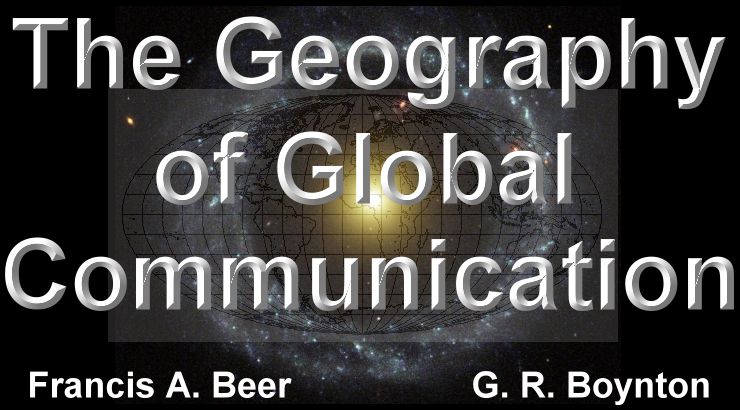
 |
This is one of the images that comes to mind when we think global. It is one of the most common images for representing the world.
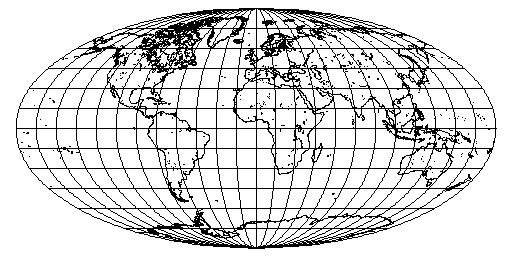 |
However, two dimensions is not a very satisfactory representation of the globe. CNN's WorldView and BBC's World News both adopted a spinning globe.
 |
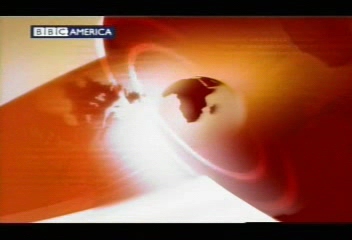 |
The spinning globe represents their commitments to serve a global audience. And this leads to rather unusual programming. The U.S. media generally devote one-third, or less, of their broadcasts to global afffairs. In contrast more than two-thirds of the stories broadcast by WorldView and World News are global in focus [Beer and Boynton, Global Media]. They broadcast for a global audience; they broadcast for an audience attentive to global affairs.
It is possible to broadcast for a global audience only as the result of far reaching changes in the technology of transportation and communication. What took Marco Polo years, what took later adverturers months, now requires only hours -- to traverse the globe. Distance was measured primarily in miles -- physical contiguity. But the parallel systems of transportation and communication were both tied to the same technology. Thus, Far East was not only about time consuming to get there. It was also unknown; communication was too little and too slow. Now, satellite uplinks and downlinks combined with increasingly light weight recording equipment means that networks can broadcast from anywhere to anywhere in real time.
It was not many decades ago that pita bread was exotic fare. Today pita can be found in grocery stores all over the United States. Communication has brought the exotic into our homes.
Near and far take on a new dimensionality. Instead of being measured in miles, near and far are measured in communication. What you know about is familiar -- not distant. What you do not know about is distant, strange, and perhaps exotic. For the news media, space becomes story space [Beer and Boynton, Story Time and Story Space], and their stories become our familiar and unfamiliar.
That leads us to look at a new geography -- the geography of global communication. Which countries are familiar in the stories they tell? Which are unfamiliar? To answer these questions we recorded and counted. We recorded three years of WorldView broadcasts -- 1998 through 2000, when it was discontinued. We have recorded two years of BBC's World News -- 2001 through present. At this point we have 852 broadcasts in the database for counting [for further explication: Counting].
Who is in and who is not?
Which countries are in the news? Which countries are not? If you count the appearance of countries across the entire period the distribution looks like this figure. One country dominates -- being in the news more than any other.
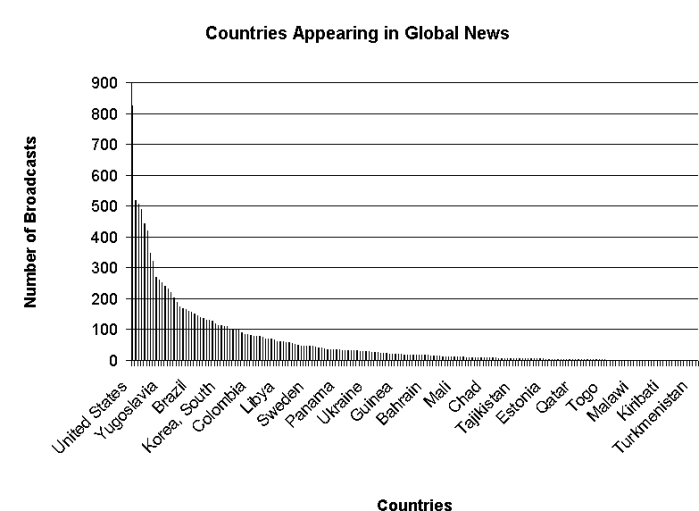 |
Then you have something that looks roughly like a geometrically decreasing function [Full Counts]. It is not clear from this figure, but only 16 of the 190 countries were absent from the global news broadcasts. The rest appeared at least one time.
The 'major players' are listed in the table. The United States appeared in more than 800 broadcasts. The major powers or G8, whichever you prefer, dominate the upper reaches of the table. All eight members of the G8 were in stories more than 200 days.
|
800+
|
599-300
|
299-200
|
199-100
|
| United States | Britain | India | Pakistan |
| Russia | Japan | Afghanistan | |
| Israel | Yugoslavia | Bosnia | |
| Iraq | Iran | Saudi Arabia | |
| China | Germany | Mexico | |
| France | Italy | Brazil | |
| Canada | Cuba | Ireland | |
| Syria | |||
| South Africa | |||
| Jordan | |||
| Georgia | |||
| North Korea | |||
| Indonesia | |||
| Egypt | |||
| Albania | |||
| South Korea | |||
| Vietnam | |||
| Lebanon | |||
| Australia | |||
| Spain | |||
| Turkey |
The other seven countries, which appeared on more than 200 days, provide hints about what it takes to get into the news. Iraq is present beyond all proportion to size and wealth. However, it was on the United Nations hit list for most of the period we counted. That put it in the news with the major powers. The Palestinian-Israeli conflict was regularly followed by the global news broadcasters; Israel appeared 489 days and Palestinian [not yet a country] appeared 435 times. The Kosovo-Yugolav conflict in 1998 and 1999 brought both into the news disportionately to their size and wealth. Yugoslavia appeared in 319 broadcasts and Kosovo [not a country] appeared in 282 broadcasts. Small things may matter -- if you extract Elian Gonzalez from the Cuba counts the country would be much farther down the list.
The major powers make the news. Conflicts may propel the parties to the conflict into the news with regularity. And a good story -- one that tugs at the heart strings -- may propel a country into the news if the story goes on long enough.
You can picture a world that is organized by distance. You can picture it in two dimensions. You can picture it in three dimensions. What about a world organized by communication? What would this world look like if it was pictured in terms of communication?
 |
While wandering around the NASA website -- they are very good about picturing our world -- we found this galaxy. It seemed just right: a very strong center light surrounded, at some distance, by a circle of lesser lights.
It is also apt because it so easily morphs into this image.
 |
Which so easily morphs into
 |
what happens to the center of attention.
Continuity and Spikes of Attention
The overall distribution is only part of the story. There are at least three other patterns that are worth noting as they have an impact on the familiarity of the news makers -- the geography of global communication.
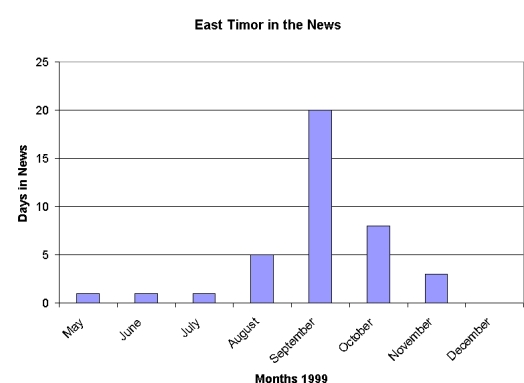 |
One, there are spikes of attention; a story that makes it into the news repeatedly. Any story that appears twenty out of twenty-two days in a month is one that the news broadcasters have deemed important, and it appears frequently enough that the audience will remember it. If the story is short lived then it becomes a temporary spike of attention.
The independence of East Timor was a story like that. East Timor was mentioned only once in 1998. It was not mentioned in 1999 until May. One story in May, one story in June, and one story in July. Then five stories in August because of the conflict between the East Timorese who wanted independence and those who did not. The conflict peaked in September with 20 stories. That declined to eight stories in October and three stories in November. By December it was out of the news. It was a temporary spike, but at its peak it was daily news.
Stories about Chechnya in 1999 and 2000 had something of the same character.
| 1999/2000 | Aug | Sep | Oct | Nov | Dec | Jan | Feb | Mar | Apr | May | Jun |
| Stories | 5 | 6 | 13 | 16 | 15 | 17 | 11 | 9 | 3 | 3 | 4 |
This was the second conflict between the Russian government and the Chechnyan insurgents [or terrorists]. It lasted longer than the East Timor spike -- ten month or so -- and it did not go away as completely as did East Timor. It would reappear after this spike. Nevertheless, it was a temporary spike that brought to the attention of the global audience a 'remote' region of the world that they otherwise would have had little reason to know about.
A second pattern is competition for attention. Iraq and the United Nations in 1998 and 1999 was in direct competition with Kosovo and NATO for attention.
| Jan-May 98 | June-Oct 98 | Nov-Dec 98 | Jan-Mar 99 | Apr-Sept 99 | |
| Iraq | [59] | 27 | [29] | 37 | 29 |
| Kosovo | 22 | [50] | 6 | 46 | [93] |
Early in 1998 the United Nations was actively negotiating with the Iraqi regime to re-invigorate the work of UNSCOM. Kosovo was barely on the screen. That shifted in June to October of that year. The UNSCOM inspectors were doing their jobs and Yugoslavia was repressing the Kosovars while NATO nations watched and threatened. Then in November Iraq threw the UNSCOM inspectors out and the U.N. began threatening. In December the United States and Britain bombed Iraq with the blessing of the U.N. security council. In January through March 1999 Iraq was still on the scene after the bombing. And negotiations with and threats directed to Yugoslavia increased until late in March when the NATO nations attacked. The conflict was short lived; it lasted from late March through June. So, April through September were very heavily occupied by the conflict and the aftermath.
Part of the shifting number of days featuring the two stories was the result of the shifting tides of events. But it is clear that, at least, in November-December 1998 and April-September 1999 attention was so tightly focused on one or the other of the conflicts that there was little time left for the other. That was true for the political actors involved. It was equally true of the news media. Time is a finite resource for the news broadcasters. On average, these two networks broadcast about 10 stories per day. But in these two situations there were many days in which there was only one story -- the conflict.
The third pattern is constancy. That is especially apparent when there is a dominant presence. The United States was always present during this period. That does not mean they were involved in every story, but they were there almost every day.
China was not a dominant presence, though it was in the news more than 300 times during the period. However, it was a constant presence. Averaging over six month periods there were between 8 and 10 stories per month.
| Jan-Jun 1998 | July-Dec 1998 | Jan-Jun 1999 | July-Dec 1999 | |
| China | 53 | 46 | 67 | 57 |
Unlike Yugoslavia or Chechnya or Israel, China was not there for only one story. There was no dominant story. The stories changed while the number of stories reported remained more or less constant. A government official visiting the United States. Negotiations concerning the World Trade Organization. Human rights in China. The suspicion of espionage: spies sending nuclear secrets to the Chinese government. Work at the United Nations Security Council. The list of stories that mention China is long and diverse. This is the pattern to be expected of major powers. They make the stories -- not just one.
The Barely Noticed
Eighty-eight countries were mentioned in the news broadcasts twenty times or fewer. Kazakhstan was there twenty times. Fifteen countries vied for the bottom -- appearing only once.
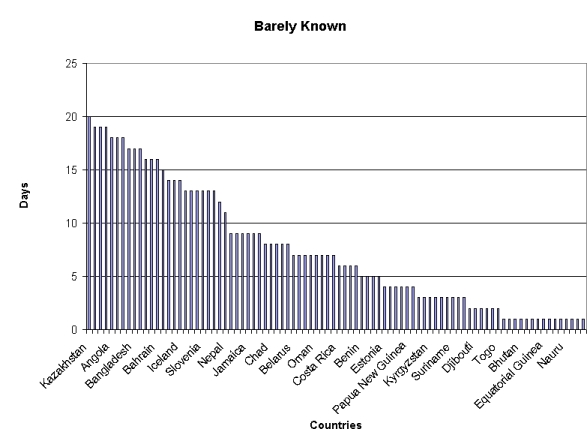 |
The decline would be better fitted to a straight line than to a geometric curve. There are a few countries at every level of reporting. The major exception to the steady decline is the large number that only appeared once.
What does it take? If a country is so inconsequential that it makes it into the news very, very infrequently what will propel it into the news on those few occasions?
War and rumors of war head the list of topics that brings these nations into the news. Thirty-one percent of the stories are about wars from within and without. Natural disasters and visits of distinguished persons tie for second with ten percent each. It is a violent world -- at least that is what the global news media bring to their viewers.
Conclusion
Uplinks. Satellites. Downlinks. The only distance that matters in communication is the distance involved in sending a signal up and then down. The close connection between communication and transportation has been broken. Near and far -- familiar and unfamiliar -- can be constituted by communication. The rhythm of day and night, as it moves around the globe, remains. We can watch a war in Iraq in real time -- except that we are asleep and can wait until we awake to watch the battles. But the images and sounds are just as real as if they were just over the horizon. And that is what they are. Contemporary communication has put everywhere just over the horizon.
We have, however, traded one constraint for another. Transportation, or distance, is no longer a constraint on communication. But there is the constraint of finitude. News broadcasters have only twenty-four minutes in which to report the happenings of the world. They have no difficulty reporting about an earthquake in Turkey, a war in Iraq, an earthquake in the mountains of Afghanistan or a meeting of political leaders in Kyrgyzstan. They do have to shoe horn it into only twenty-four minutes. And that produces a new geography -- the geography of global communication. Which nations are familiar and which are not? Which subjects are familiar and which are not? The answer is given by the broadcasters' conception of importance to a global audience operating under the constraint of twenty-four minutes. That is what we have explored in this paper.